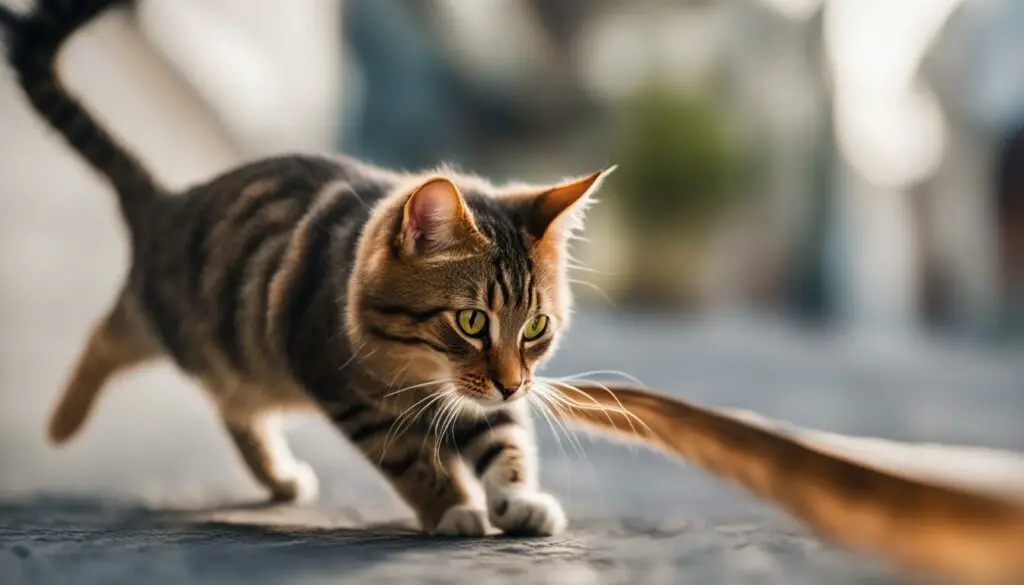Cats are fascinating creatures, with their own unique ways of expressing themselves. One intriguing behavior that many cat owners may have noticed is when their feline companion taps their tail. But what does it mean? Is it a sign of happiness or something else entirely?
Understanding cat tail language is essential for deciphering their emotions and intentions. By paying attention to the movements and positions of your cat’s tail, you can gain valuable insights into their moods and behaviors. It’s like having a secret code that only you and your cat can understand.
Whether it’s a gentle tap or a rapid flick, each tail movement carries a specific meaning. In this article, we will explore the fascinating world of cat tail language and help you become fluent in understanding what your cat’s tail is trying to tell you.
Key Takeaways:
- Cat tail language is a complex form of communication, and understanding it can deepen the bond between cats and their owners.
- Observing the movements and positions of a cat’s tail can provide insights into their emotions and behaviors.
- Tail tapping can indicate a variety of emotions, including curiosity, playfulness, anxiety, or stress.
- Different tail positions convey different meanings, such as confidence, aggression, or submission.
- Responding appropriately to cat tail language can enhance communication and strengthen the relationship between cats and their owners.
The Basics of Cat Tail Language
Cat tail language is a complex form of communication that involves various movements and positions of the tail. Understanding cat tail language is essential for cat owners to decipher their feline companions’ emotions and behaviors. By observing the subtle cues of the tail, you can gain valuable insights into your cat’s moods and intentions. Let’s delve into the basics of cat tail language and how to interpret them.
The movements of a cat’s tail can convey specific meanings. A flicking or lashing tail indicates agitation or annoyance, while a slowly waving tail suggests focus or readiness to pounce. A tail held high and curved slightly at the end signifies a friendly approach. Cats may also use their tails to bond with other cats or humans by curving or intertwining them. These basic tail movements serve as the foundation for understanding a cat’s emotions and intentions.
The positions of a cat’s tail also play a significant role in communication. An upright, held high tail generally indicates confidence and happiness. On the other hand, a tail that hangs straight down signifies agitation or aggression. When a cat curves its tail beneath its body, it is likely feeling nervous or submissive. A puffed tail indicates fear or agitation. By observing these tail positions, you can better understand how your cat is feeling and respond appropriately.
| Tail Movement | Meaning |
|---|---|
| Flicking or lashing | Agitation or annoyance |
| Slow waving | Focus or readiness to pounce |
| Tail held high, curved at the end | Friendly approach |
| Tail hanging straight down | Agitation or aggression |
| Curved beneath the body | Nervousness or submission |
| Puffed tail | Fear or agitation |
Understanding the basics of cat tail language is the first step to decoding your furry friend’s emotions and behaviors. By paying attention to the movements and positions of their tail, you can better respond to their needs and strengthen your bond. Stay tuned for the next section, where we will explore how to interpret specific cat tail positions and what they mean.
Interpreting Cat Tail Positions
Understanding the position of a cat’s tail is key to deciphering their emotions and behaviors. The way a cat holds and positions their tail can provide valuable insights into their emotional state. Here are some common cat tail positions and their meanings:
Tail held upright
When a cat holds their tail upright and held high, it generally indicates confidence and happiness. It’s a positive sign that your cat is feeling content and secure in their environment. This tail position can also signify a friendly approach and a willingness to engage with others.
Tail hanging straight down
If a cat’s tail is hanging straight down, it is a clear sign of agitation or aggression. This tail position often accompanies hostile behaviors and should be approached with caution. It’s best to avoid engaging with a cat when their tail is in this position, as they may lash out or become defensive.
Tail curved beneath the body
When a cat curves their tail beneath their body, it indicates nervousness or submission. This tail position suggests that your cat may be feeling anxious or unsure about their surroundings. It’s important to create a calm and secure environment for your cat when you notice this tail position, providing them with reassurance and comfort.
By paying attention to these tail positions, you can gain a better understanding of your cat’s emotional state and respond appropriately to their needs. Remember that each cat is unique, and their tail language may vary slightly from one individual to another. Observing your cat’s tail movements in conjunction with their overall body language will help you build a stronger bond and deepen your understanding of their needs.
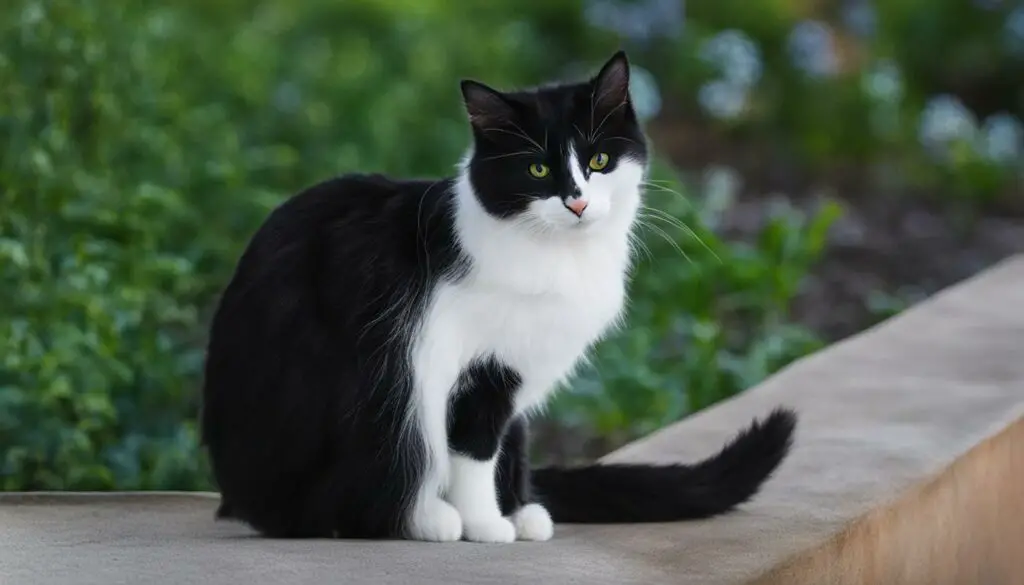
| Tail Position | Meaning |
|---|---|
| Upright tail held high | Confidence and happiness |
| Straight down tail | Agitation or aggression |
| Curved tail beneath the body | Nervousness or submission |
Cat Tail Language: Understanding and Responding to Your Cat’s Signals
Understanding cat tail language is essential for cat owners to establish a strong bond with their feline companions. By observing the movements and positions of a cat’s tail, we can gain valuable insights into their emotions and behaviors. In this section, I’ll outline how you can respond effectively to cat tail language, promoting better communication and enhancing your relationship with your cat.
How to Respond to Cat Tail Positions
When deciphering cat tail language, it’s crucial to respond appropriately to the different tail positions. An upright and held high tail signifies confidence and happiness. In such cases, we can offer playtime, cuddles, and treats to reinforce their positive emotions.
On the other hand, a tail that hangs straight down indicates agitation or aggression. It’s important not to engage or pet a cat when their tail is in this position. Instead, we should give them space and allow them to calm down.
When a cat curves their tail beneath their body, they are likely feeling nervous or submissive. It’s essential to approach them gently and provide reassurance and a safe environment. By responding to cat tail positions appropriately, we can create a sense of trust and understanding between us and our furry friends.
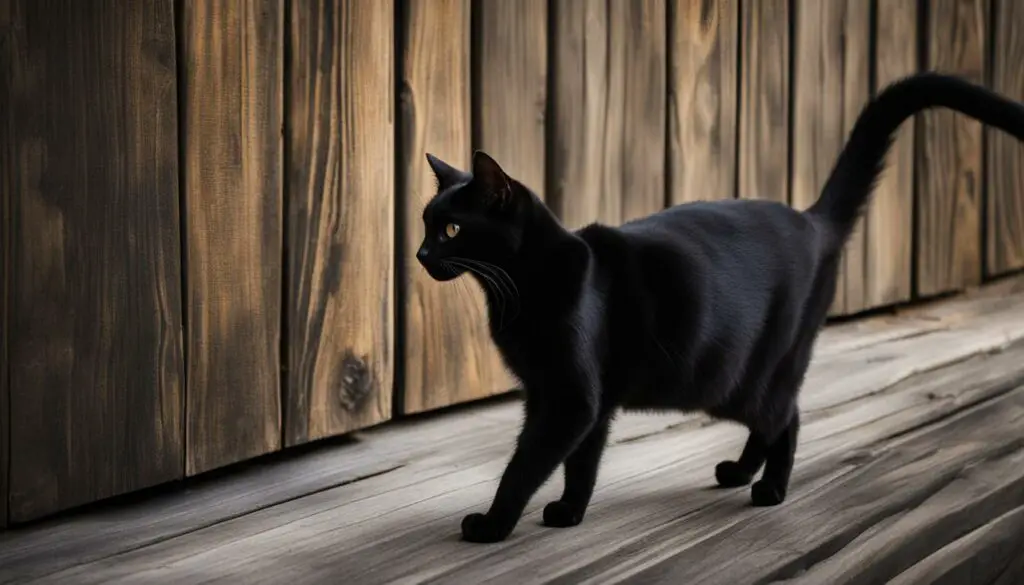
The Importance of Paying Attention to Cat Behavior
While cat tail language is an essential part of communication, it’s important to remember that it’s just one piece of the puzzle. It’s crucial to observe your cat’s entire body language and behavior to gain a comprehensive understanding of their emotions and needs.
By responding to cat tail positions appropriately, we can create a sense of trust and understanding between us and our furry friends.”
Factors such as ear position, facial expressions, and vocalizations can provide additional insights into your cat’s state of mind. By paying attention to these cues and responding accordingly, we can ensure a harmonious and fulfilling relationship with our feline companions.
Summary
Responding to cat tail language requires sensitivity and understanding. By recognizing and responding appropriately to different tail positions, we can effectively communicate with our cats and strengthen our bond. However, it’s important to remember that tail language is just one aspect of a cat’s communication, and we should also observe their overall behavior and body language. Through attentive observation and appropriate responses, we can create a nurturing and loving environment for our beloved feline friends.
Dealing with Aggressive Cat Tail Behaviors
Aggressive cat tail behaviors can be challenging to handle, but understanding their underlying causes is the key to addressing them effectively. Cats may exhibit aggressive tail postures, such as whipping back and forth or holding their tail high and rapidly moving it, when they feel fearful or threatened. It’s important to recognize these signs of aggression and avoid attempting to snuggle or engage with an angry cat.
To manage aggressive cat tail behaviors, it’s crucial to identify the specific triggers. Fear and territoriality are common causes of aggression in cats. Creating a calm and enriching environment can help alleviate stress and reduce aggressive tendencies. Providing cats with appropriate resources, such as scratching posts and hiding spots, can also help redirect their aggressive behaviors. However, if the aggression persists or worsens, it’s advisable to seek professional help from a qualified cat behavior expert.
Recognizing Aggressive Cat Behaviors:
- Whipping back and forth tail
- Tail held high and moving rapidly
- Growling, hissing, or bared teeth
- Arched back and piloerection (raised fur)
A cat’s tail language can provide valuable insights into their emotions and behaviors. By understanding and addressing aggressive cat tail behaviors, cat owners can create a safer and more harmonious environment for both the cat and themselves.
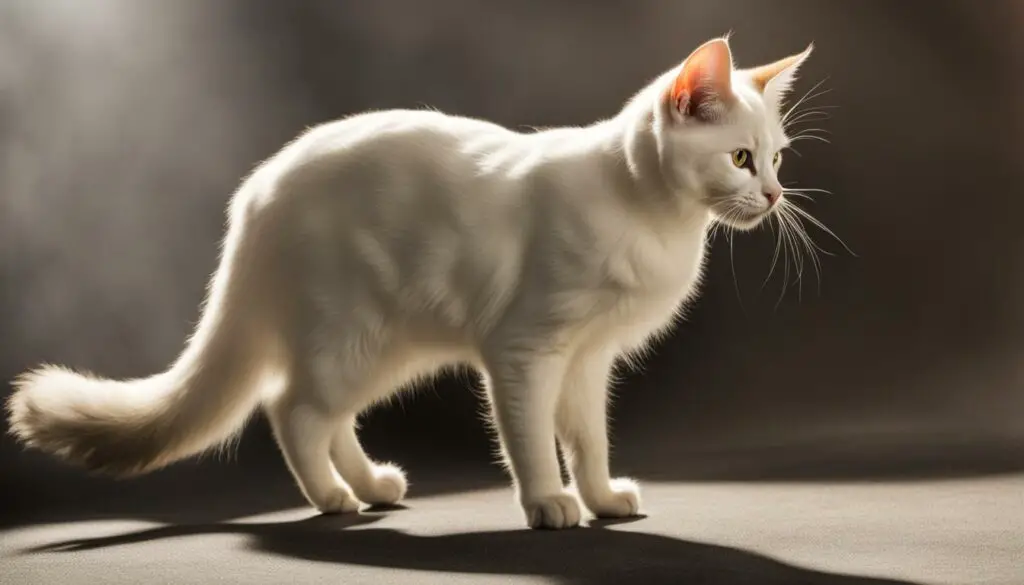
Common Causes of Cat Tail Behaviors
Understanding the various tail behaviors exhibited by cats is crucial for cat owners to communicate effectively with their feline companions. Cat tail behaviors can be influenced by various factors, including anxiety, stress, and aggression. By recognizing and addressing the underlying causes of these behaviors, cat owners can create a calm and harmonious environment for their cats.
Causes of Cat Aggression
Cat aggression can manifest in different tail behaviors. A tail held high and rapidly moving back and forth may indicate fearfulness or aggression. Cats may become aggressive when they feel threatened or territorial. It’s important to create a safe space for your cat and provide adequate resources to minimize these aggressive behaviors.
Causes of Cat Anxiety
Anxious cats may display specific tail behaviors, such as rapid twitching or tightly wrapping their tails around their bodies. Common causes of cat anxiety include changes in the environment, separation anxiety, or past traumatic experiences. Creating a calm and enriching environment, maintaining a consistent routine, and providing appropriate outlets for play and relaxation can help alleviate anxiety-related tail behaviors.
Causes of Cat Stress
Stress can also contribute to cat tail behaviors. Cats may exhibit tail behaviors such as lashing or flicking when they feel stressed. Common stressors for cats include changes in their routine, introduction of new pets, or loud noises. Identifying and minimizing sources of stress can help reduce these tail behaviors and promote a more relaxed and contented feline.
In summary, understanding common causes of cat tail behaviors such as aggression, anxiety, and stress is essential for cat owners to create a nurturing and supportive environment for their cats. By addressing these underlying causes and providing appropriate outlets for emotional and physical wellbeing, cat owners can help their feline companions lead happy and fulfilled lives.
| Common Causes of Cat Tail Behaviors | Description |
|---|---|
| Aggression | Cat aggression can lead to tail behaviors such as a high and rapidly moving tail. Common causes include territoriality and feeling threatened. |
| Anxiety | Cat anxiety can manifest in tail behaviors like rapid twitching or tightly wrapping the tail around the body. Causes include changes in environment and past trauma. |
| Stress | Cat stress can result in tail behaviors such as lashing or flicking. Common stressors include changes in routine and introduction of new pets. |
Relationship Between Cat Tapping Tail and Emotions
When it comes to understanding our feline companions, decoding their behaviors and emotions is essential. One intriguing behavior that cats display is tapping their tail. Cat tapping tail can be a sign of various emotions and behaviors, offering insights into how they’re feeling.
When a cat taps its tail repeatedly, it can indicate playfulness, curiosity, or anticipation. It’s a way for them to release their energy and express their excitement. However, tapping of the tail can also be a sign of anxiety or stress, especially when accompanied by other stress-related behaviors. As responsible cat owners, it’s important to pay attention to the context and accompanying body language to accurately interpret the specific emotions behind cat tail tapping.
By observing these cues, we can better respond to our cat’s emotional needs. Engaging in playtime, providing interactive toys, and creating a calm and enriching environment can help alleviate stress and anxiety in our feline companions. Remember, each cat is unique, so it’s essential to pay attention to their individual behaviors and tailor our responses accordingly.
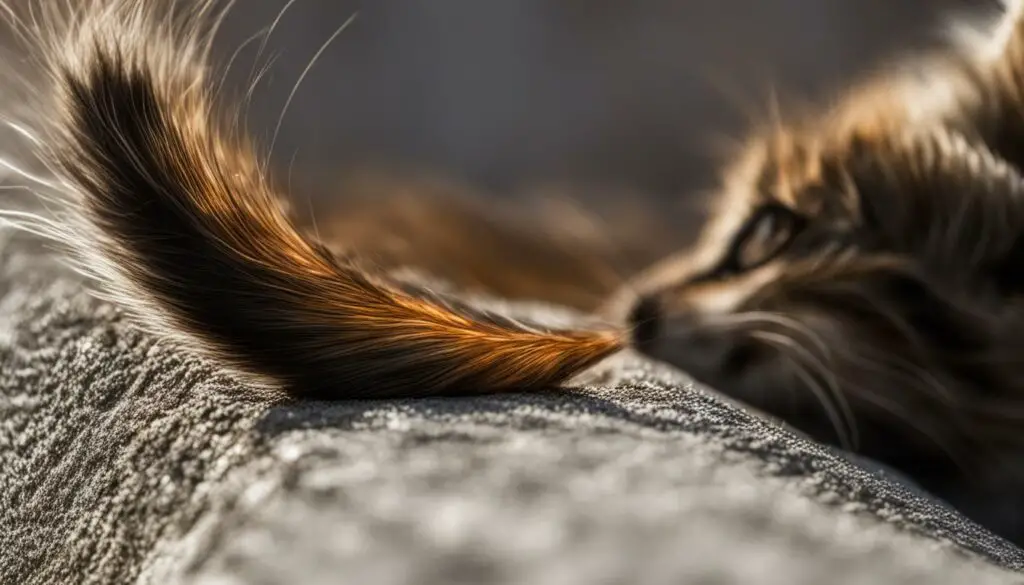
Cat tapping tail is just one aspect of their complex communication system. By paying attention to their tail language, along with other body cues, we can deepen our understanding of our cats’ emotions and strengthen the bond we share with them.
The Role of Cat Tail Language in Bonding and Socialization
Understanding cat tail language is essential for building a strong bond and facilitating socialization with your feline companion. Cats use their tails as a means of communication, expressing their emotions and intentions. By observing and interpreting their tail movements and positions, you can gain valuable insights into your cat’s feelings and needs.
“The tail is a vital part of a cat’s body language, playing a significant role in bonding and social interaction. It serves as a visual cue, allowing cats to establish positive connections with other cats and humans.”
When a cat wraps their tail around another cat or human, it signifies trust and comfort. By responding positively and respectfully to these tail behaviors, you can strengthen the bond with your cat and foster a harmonious relationship. Conversely, understanding when a cat may be feeling anxious or stressed, as indicated by specific tail positions, can help you create a calming environment and provide support when needed.
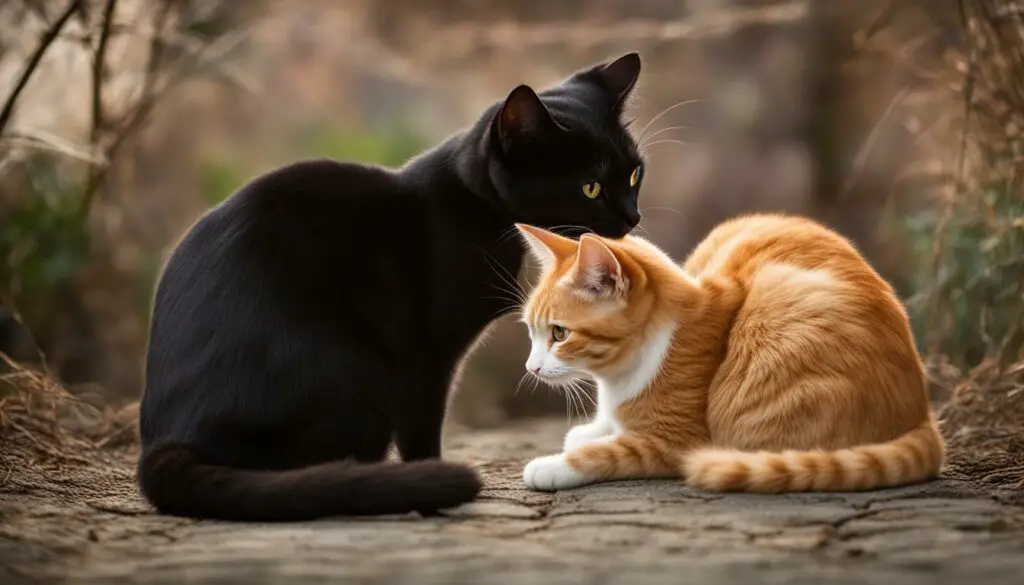
Remember, each cat is unique, and tail language may vary slightly among individuals. Taking the time to observe and understand your cat’s tail movements and positions will allow you to communicate effectively and build a stronger connection with your feline companion.
Notable Cat Tail Movements and Their Meanings
Cat tail movements are an important aspect of feline communication, providing valuable insights into their behaviors and emotions. Understanding these movements can help cat owners better interpret their cats’ intentions and respond appropriately to their needs. Here are some notable cat tail movements and their meanings:
- Flicking or lashing tail: When a cat rapidly flicks or lashes their tail, it typically indicates agitation or annoyance. It’s a warning sign that they’re feeling uncomfortable or irritated.
- Slow swaying or twitching: A cat’s tail that sways slowly or twitches sporadically suggests focus and attention. They are likely observing their surroundings or preparing to engage in a specific activity.
- Puffed tail: When a cat’s tail puffs up, it signifies fear or aggression. It’s a defensive posture that the cat adopts when feeling threatened or unsafe.
By observing and interpreting these tail movements in conjunction with other body language cues, such as ear position and vocalizations, cat owners can gain a deeper understanding of their cats’ emotions and behaviors. Remember, each cat is unique, so it’s important to consider their individual personalities and experiences when interpreting their tail movements.
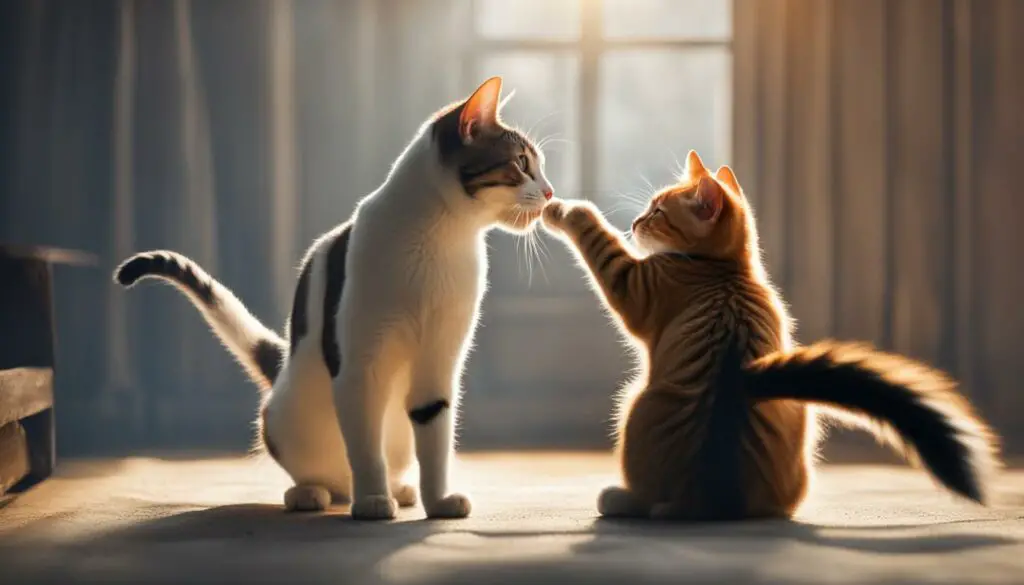
Through careful observation and interpretation, cat owners can build stronger bonds with their feline companions and ensure their overall well-being.
The Importance of Tailless Cats’ Communication Methods
Tailless cats, such as Manx or Bobtail breeds, have their unique way of communicating their intentions and emotions. Despite the absence of a tail, these cats rely on other aspects of body language to convey their feelings. Through ear position, facial expressions, and stance, tailless cats can still effectively communicate with humans and other animals. It is important for cat owners to pay attention to these alternative communication methods to understand and respond appropriately to their tailless feline companions.
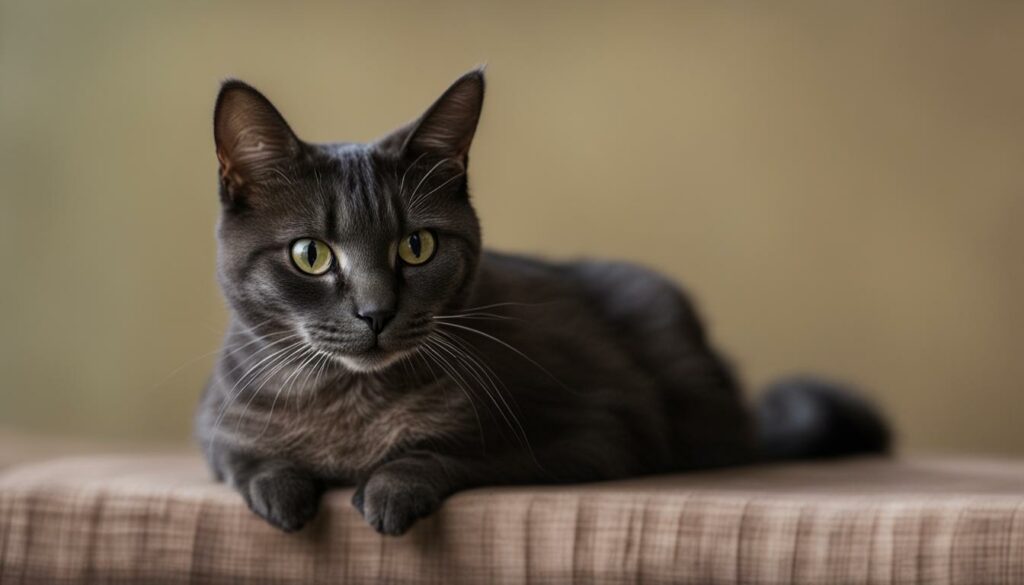
Without a tail, tailless cats may approach other dogs or people cautiously to avoid miscommunication. They rely on their body language to signal whether they are feeling comfortable or anxious in a particular situation. For example, a tailless cat may flatten their ears and crouch down if they feel threatened or scared. On the other hand, a tailless cat may have relaxed facial expressions and an upright stance when they are feeling relaxed and confident. By paying attention to these non-verbal cues, cat owners can effectively understand and respond to their tailless cats’ communication needs.
Just like their tailed counterparts, tailless cats also rely on their body language to establish social bonds and express their emotions. They may rub their bodies against other animals or humans to show affection and trust. Additionally, tailless cats can also use vocalizations, such as purring or meowing, to communicate their needs and emotions. By observing and responding to these different forms of communication, cat owners can build a strong and loving relationship with their tailless feline companions.
In conclusion, while tailless cats may lack a tail, their ability to communicate through alternative body language methods should not be underestimated. By paying attention to ear position, facial expressions, and stance, cat owners can effectively understand and respond to their tailless cats’ communication needs. This understanding fosters a strong bond and enhances the overall well-being of the cat. So, whether a cat has a tail or not, effective communication and understanding remain key to a fulfilling relationship between cats and their human companions.
The Role of Speed in Cat Tail Wagging
When it comes to cat tail wagging, the speed at which their tails move can provide valuable insights into their emotions. A fast wagging tail is often a sign of excitement or arousal. It indicates that the cat is highly engaged and may be ready to play or hunt. On the other hand, a slow swaying tail suggests a different state of mind. It signifies focus and attention, as if the cat is carefully observing its surroundings or preparing to make a move.
Speed is not the only factor to consider when interpreting cat tail wagging. It’s essential to also observe the accompanying body language and the overall context. A cat with a fast wagging tail, accompanied by puffed fur and a tense posture, may be feeling insecure or threatened. In contrast, a slow swaying tail, along with relaxed body language and a content expression, indicates that the cat is at ease and comfortable in its environment.
Understanding the role of speed in cat tail wagging can help cat owners better gauge their feline companion’s emotions and respond accordingly. It allows for a deeper understanding of their needs and preferences, strengthening the bond between cat and owner. So, the next time you notice your cat wagging its tail, pay attention to the speed and the overall context to gain valuable insights into their state of mind and well-being.
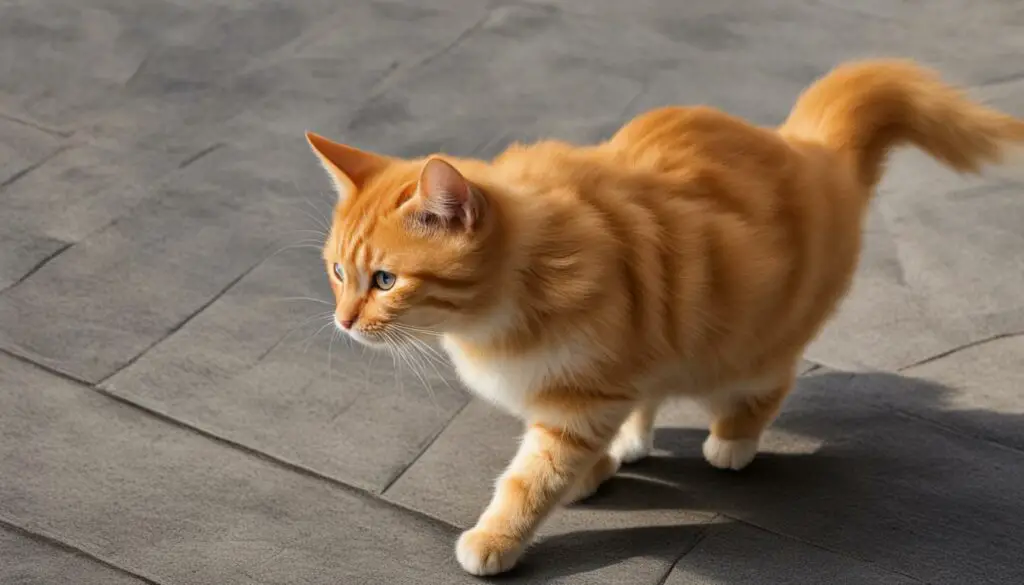
The Importance of Body Language
It’s important to note that cat tail wagging is just one aspect of their overall body language. To fully understand a cat’s emotions and intentions, it’s essential to consider other cues such as ear position, facial expressions, and overall stance. These non-verbal cues work together to form a comprehensive picture of a cat’s emotional state.
For example, a cat with a fast wagging tail and ears flattened against its head may be feeling fearful or threatened. In contrast, a slow swaying tail, accompanied by relaxed ears and open eyes, indicates a more relaxed and content state.
By paying attention to the intricacies of cat body language, including the speed of tail wagging, cat owners can better communicate and connect with their feline friends, providing a safe and enriching environment for them to thrive.
The Direction of Cat Tail Wagging and Its Significance
Cat tail wagging is a fascinating form of communication that can provide insights into a cat’s emotional state. But did you know that the direction of a cat’s tail wagging carries significance? Just like dogs, cats have a preferred direction for wagging their tails, and it can indicate their underlying emotions.
When a cat wags its tail to the right side, it generally signifies positive emotions such as happiness or confidence. This is because the left side of a cat’s brain, which controls the right side of their body, is associated with positive emotions. On the other hand, when a cat wags its tail to the left side, it may indicate negative emotions such as fear or anxiety. This is because the right side of the brain, which controls the left side of their body, is associated with negative emotions.
Understanding the direction of a cat’s tail wagging can help cat owners better interpret their feline’s emotional state. It allows us to gauge whether they are feeling content and relaxed or if they are experiencing stress or discomfort. By paying attention to this subtle yet significant cue, we can respond appropriately and provide the support and care our cats need.
The Significance of Tail Wagging Direction
The direction of cat tail wagging is closely tied to their brain hemispheres, which regulate different emotions and behaviors. By recognizing this connection, we can gain deeper insights into our cats’ feelings and tailor our interactions accordingly.
| Direction of Tail Wagging | Associated Emotions |
|---|---|
| To the right | Happiness, confidence |
| To the left | Fear, anxiety |
As an example, if you approach your cat and notice their tail wagging to the right, it’s a good sign that they are in a positive mood and open to interaction. On the other hand, if their tail is wagging to the left, it’s best to proceed with caution and give them space to feel more at ease.
Remember, tail wagging is just one aspect of a cat’s overall body language and should be considered alongside other cues such as ear position, vocalizations, and facial expressions. By paying attention to these subtle signals, we can communicate effectively with our cats and strengthen our bond with them.
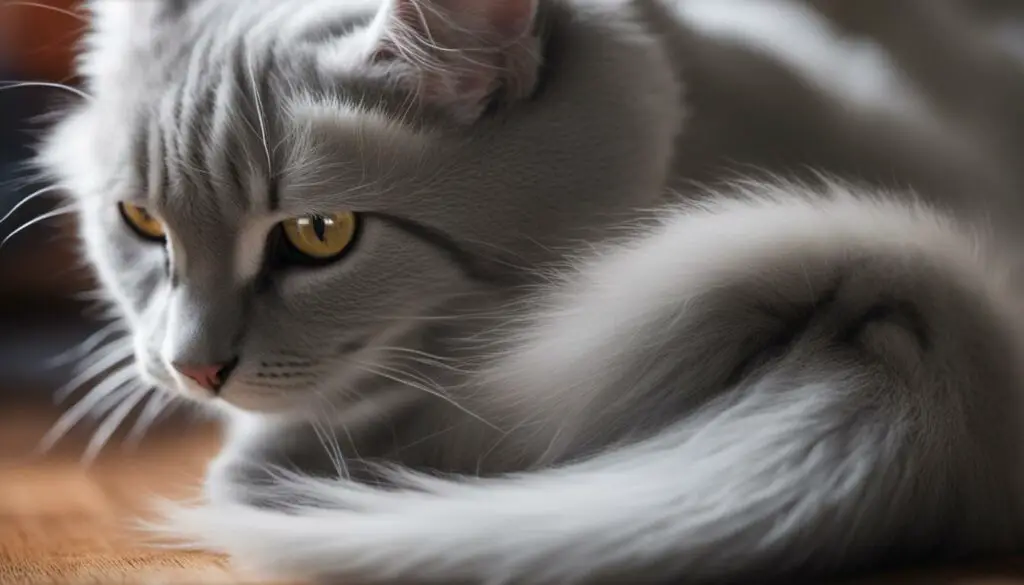
By understanding the direction of your cat’s tail wagging, you can gain valuable insights into their emotions and provide the appropriate care and attention they need. Pay attention to their tail movements, along with other forms of body language, to ensure a harmonious and fulfilling relationship with your feline companion.
Recognizing Various Tail Positions and Their Meanings
Understanding the various tail positions of cats is essential for decoding their communication. The position of a cat’s tail can provide valuable insights into their emotions and intentions. Here are some common tail positions and their meanings:
1. Upright Tail
A cat with an upright tail held high indicates contentment and confidence. This position signifies a happy and relaxed cat.
2. Tail Hanging Down
A tail hanging down straight indicates aggression or agitation. This position suggests that the cat may be feeling threatened or defensive.
3. Curved Tail beneath the Body
When a cat curves their tail beneath their body, it suggests nervousness or submission. This position may indicate that the cat is feeling anxious or unsure.
4. Puffed Tail
A puffed tail is a sign of fear or aggression. When a cat puffs up their tail, it’s typically a defensive response to perceived danger or stress.
By recognizing and understanding these various tail positions, cat owners can better interpret their cat’s emotions and respond appropriately to their needs.
| Tail Position | Meaning |
|---|---|
| Upright Tail | Contentment and confidence |
| Tail Hanging Down | Aggression or agitation |
| Curved Tail beneath the Body | Nervousness or submission |
| Puffed Tail | Fear or aggression |
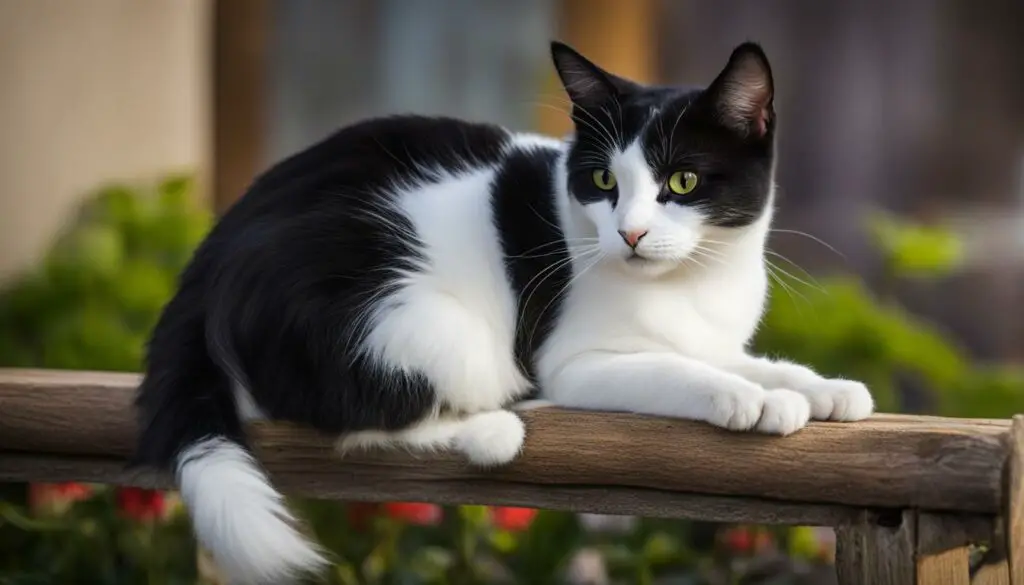
Recognizing and interpreting cat tail positions can help foster a deeper understanding of your feline companion. By paying attention to their tail language, you can respond to their emotions and ensure a harmonious relationship. Remember, each cat is unique, so it’s important to observe their overall body language and context to get a complete picture of their feelings.
When to Seek Professional Help for Cat Tail Behaviors
While understanding and responding to cat tail behaviors is crucial for cat owners, there may be instances where seeking professional help becomes necessary. If your cat’s tail behaviors persist or become problematic, consulting a qualified cat behavior expert is recommended. These experts have the knowledge and experience to assess your cat’s behavior, identify any underlying causes, and provide personalized strategies for addressing and modifying challenging tail behaviors.
Professional help is especially important when dealing with aggressive cat tail behaviors. A cat with a whipping back and forth tail or a tail held high and moving rapidly may be showing signs of fearfulness or aggression. Handling such situations incorrectly can worsen the behavior or even lead to injury. A cat behavior expert can guide you on how to safely manage and modify these aggressive tail behaviors, ensuring the well-being of both you and your cat.
In addition to addressing specific tail behaviors, a cat behavior expert can also evaluate your cat’s overall well-being and identify any underlying health issues that may contribute to the behaviors. They can provide recommendations on creating a calming and enriching environment for your cat, as well as offering guidance on appropriate resources and activities to reduce stress and anxiety.
Remember, seeking professional help does not mean you have failed as a cat owner. It shows your commitment to your cat’s happiness and well-being. By working with a cat behavior expert, you can gain valuable insights into your cat’s tail behaviors and develop effective strategies to improve their behavior and strengthen your bond.

In summary, professional help should be sought for cat tail behaviors that persist, become problematic, or show signs of aggression. A qualified cat behavior expert can assess your cat’s behavior, provide personalized guidance, and help address any underlying health issues. By working with a professional, you can ensure a harmonious and happy relationship between you and your feline companion.
Conclusion
In conclusion, understanding cat tail language is essential for cat owners to effectively communicate with their feline companions. By observing and interpreting their tail movements and positions, we can gain valuable insights into their emotions, intentions, and needs. This deeper understanding can help us respond appropriately and foster a stronger bond with our cats.
By recognizing the various tail positions and their meanings, we can decipher whether our cats are feeling confident, agitated, submissive, or nervous. Tail wagging speed and direction further add to the complexity of cat tail language, providing additional clues about their emotional state. Paying attention to these cues enables us to better interpret their needs and respond accordingly.
However, if cat tail behaviors persist or become problematic, it is important to seek professional help from a qualified cat behavior expert. These experts can provide personalized guidance and strategies for addressing challenging tail behaviors, as well as assess the overall well-being of our cats. Seeking professional assistance ensures a harmonious and happy relationship between us and our feline companions.
By understanding and responding to cat tail language, we can enhance our communication, establish trust, and promote the well-being of our cats. So let’s continue to observe and appreciate the unique ways our cats communicate with us through their tails, ensuring a deeper connection and a happier, more fulfilling relationship.
FAQ
How can I understand my cat’s tail language?
By observing the movements and positions of your cat’s tail, you can decipher their moods and behaviors. Learning cat tail language takes time and practice, but it can greatly enhance the bond between you and your cat.
What do different tail movements and positions mean?
A flicking or lashing tail indicates agitation, while a slowly waving tail suggests focus or readiness to pounce. The tail-up posture signifies a friendly approach, while a tail hanging straight down signifies agitation or aggression. Curving the tail beneath the body indicates nervousness or submission, and a puffed tail indicates fear or aggression.
How should I respond to my cat’s tail language?
When your cat’s tail is upright and held high, it’s a sign of confidence and happiness. You can respond by offering playtime, cuddles, and treats. If their tail is curved at the top, you can offer your hand for sniffing and petting as a friendly gesture. It’s important not to engage with or pet a cat when their tail is straight down, as this signifies agitation and aggression.
What if my cat displays aggressive tail behaviors?
If your cat’s tail is whipping back and forth or held high and moving rapidly, it may indicate fearfulness or aggression. It’s best to avoid trying to snuggle or engage with an angry cat. Consulting a qualified cat behavior expert can help address aggressive cat tail behaviors and provide guidance on managing and modifying such behaviors.
What are some common causes of cat tail behaviors?
Cat tail behaviors can be influenced by anxiety, stress, and aggression. Cats may display aggressive tail postures when they feel threatened or territorial. They may exhibit anxious tail behaviors, such as rapid twitching or wrapping their tails tightly around their bodies. Identifying the underlying causes of these behaviors is crucial in addressing them effectively.
Does cat tail tapping have specific meanings?
Yes, when a cat taps their tail repeatedly, it may indicate playfulness, curiosity, or anticipation. It can also signal anxiety or stress. Understanding the context and accompanying body language is important in interpreting the specific emotions behind cat tail tapping.
How does cat tail language contribute to bonding and socialization?
Cats use their tails to establish positive connections with other cats or humans. They may wrap their tails around their bonded companions, demonstrating trust and comfort. By observing and responding appropriately to these tail behaviors, cat owners can foster stronger bonds and enhance their cat’s socialization with others.
What are some notable cat tail movements and their meanings?
Flicking or lashing tails indicate agitation or annoyance, slow swaying or twitching suggests focus and attention, and a puffed tail signals fear or aggression. Understanding and interpreting these tail movements can help cat owners better understand their cat’s intentions and emotions.
How do tailless cats communicate without a tail?
Tailless cats, such as Manx or Bobtail breeds, rely on other aspects of body language, such as ear position, facial expressions, and stance, to communicate their intentions. They may approach cautiously to avoid miscommunication.
Does the speed of tail wagging have any significance?
Yes, a fast wagging tail often indicates excitement, while a slow swaying tail suggests focus or attention. Tail wagging can also be a sign of insecurity or friendliness, depending on the speed and accompanying body language.
What does the direction of cat tail wagging indicate?
Dogs wag their tails to the right when feeling happy or confident and to the left when feeling frightened. The direction of tail wagging in cats may also carry significance in their communication, reflecting positive or negative emotions.
How can I recognize the various tail positions and their meanings?
An upright, held high tail indicates contentment and confidence, a tail hanging down signifies aggression or agitation, and a tail curved beneath the body suggests nervousness or submission. Recognizing these various tail positions allows you to interpret your cat’s emotions and respond appropriately.
When should I seek professional help for cat tail behaviors?
If cat tail behaviors persist or become problematic, it’s best to seek professional help from a qualified cat behavior expert. They can provide personalized guidance and strategies for addressing and modifying challenging tail behaviors and assess the overall well-being of your cat.

